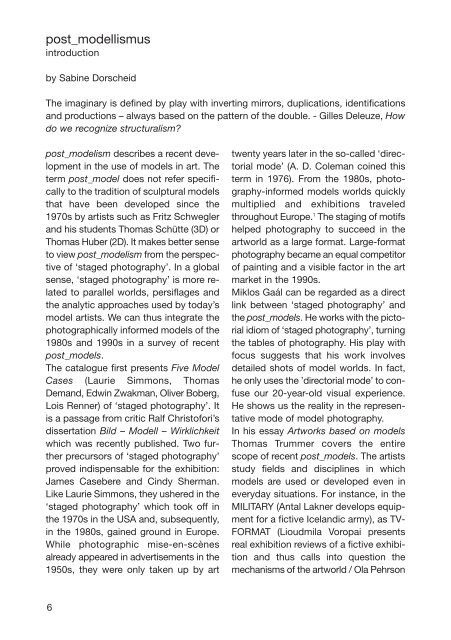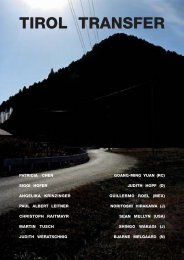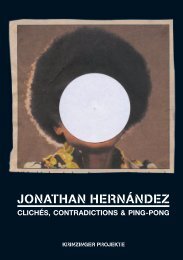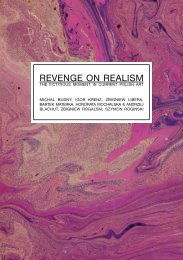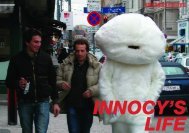post_modellismus – models in art - krinzinger projekte - Galerie ...
post_modellismus – models in art - krinzinger projekte - Galerie ...
post_modellismus – models in art - krinzinger projekte - Galerie ...
You also want an ePaper? Increase the reach of your titles
YUMPU automatically turns print PDFs into web optimized ePapers that Google loves.
<strong>post</strong>_<strong>modellismus</strong><br />
<strong>in</strong>troduction<br />
by Sab<strong>in</strong>e Dorscheid<br />
The imag<strong>in</strong>ary is def<strong>in</strong>ed by play with <strong>in</strong>vert<strong>in</strong>g mirrors, duplications, identifications<br />
and productions <strong>–</strong> always based on the pattern of the double. - Gilles Deleuze, How<br />
do we recognize structuralism?<br />
<strong>post</strong>_modelism describes a recent development<br />
<strong>in</strong> the use of <strong>models</strong> <strong>in</strong> <strong>art</strong>. The<br />
term <strong>post</strong>_model does not refer specifically<br />
to the tradition of sculptural <strong>models</strong><br />
that have been developed s<strong>in</strong>ce the<br />
1970s by <strong>art</strong>ists such as Fritz Schwegler<br />
and his students Thomas Schütte (3D) or<br />
Thomas Huber (2D). It makes better sense<br />
to view <strong>post</strong>_modelism from the perspective<br />
of ‘staged photography’. In a global<br />
sense, ‘staged photography’ is more related<br />
to parallel worlds, persiflages and<br />
the analytic approaches used by today’s<br />
model <strong>art</strong>ists. We can thus <strong>in</strong>tegrate the<br />
photographically <strong>in</strong>formed <strong>models</strong> of the<br />
1980s and 1990s <strong>in</strong> a survey of recent<br />
<strong>post</strong>_<strong>models</strong>.<br />
The catalogue first presents Five Model<br />
Cases (Laurie Simmons, Thomas<br />
Demand, Edw<strong>in</strong> Zwakman, Oliver Boberg,<br />
Lois Renner) of ‘staged photography’. It<br />
is a passage from critic Ralf Christofori’s<br />
dissertation Bild <strong>–</strong> Modell <strong>–</strong> Wirklichkeit<br />
which was recently published. Two further<br />
precursors of ‘staged photography’<br />
proved <strong>in</strong>dispensable for the exhibition:<br />
James Casebere and C<strong>in</strong>dy Sherman.<br />
Like Laurie Simmons, they ushered <strong>in</strong> the<br />
‘staged photography’ which took off <strong>in</strong><br />
the 1970s <strong>in</strong> the USA and, subsequently,<br />
<strong>in</strong> the 1980s, ga<strong>in</strong>ed ground <strong>in</strong> Europe.<br />
While photographic mise-en-scènes<br />
already appeared <strong>in</strong> advertisements <strong>in</strong> the<br />
1950s, they were only taken up by <strong>art</strong><br />
twenty years later <strong>in</strong> the so-called ‘directorial<br />
mode’ (A. D. Coleman co<strong>in</strong>ed this<br />
term <strong>in</strong> 1976). From the 1980s, photography-<strong>in</strong>formed<br />
<strong>models</strong> worlds quickly<br />
multiplied and exhibitions traveled<br />
throughout Europe. 1 The stag<strong>in</strong>g of motifs<br />
helped photography to succeed <strong>in</strong> the<br />
<strong>art</strong>world as a large format. Large-format<br />
photography became an equal competitor<br />
of pa<strong>in</strong>t<strong>in</strong>g and a visible factor <strong>in</strong> the <strong>art</strong><br />
market <strong>in</strong> the 1990s.<br />
Miklos Gaál can be regarded as a direct<br />
l<strong>in</strong>k between ‘staged photography’ and<br />
the <strong>post</strong>_<strong>models</strong>. He works with the pictorial<br />
idiom of ‘staged photography’, turn<strong>in</strong>g<br />
the tables of photography. His play with<br />
focus suggests that his work <strong>in</strong>volves<br />
detailed shots of model worlds. In fact,<br />
he only uses the ’directorial mode’ to confuse<br />
our 20-year-old visual experience.<br />
He shows us the reality <strong>in</strong> the representative<br />
mode of model photography.<br />
In his essay Artworks based on <strong>models</strong><br />
Thomas Trummer covers the entire<br />
scope of recent <strong>post</strong>_<strong>models</strong>. The <strong>art</strong>ists<br />
study fields and discipl<strong>in</strong>es <strong>in</strong> which<br />
<strong>models</strong> are used or developed even <strong>in</strong><br />
everyday situations. For <strong>in</strong>stance, <strong>in</strong> the<br />
MILITARY (Antal Lakner develops equipment<br />
for a fictive Icelandic army), as TV-<br />
FORMAT (Lioudmila Voropai presents<br />
real exhibition reviews of a fictive exhibition<br />
and thus calls <strong>in</strong>to question the<br />
mechanisms of the <strong>art</strong>world / Ola Pehrson<br />
6


